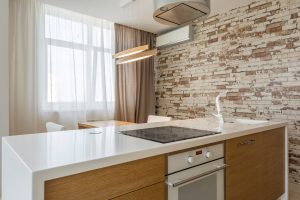If you are looking to add a touch of timeless colonial style to your kitchen, remodeling is an ideal way to do so. A colonial kitchen remodel is a great project for any homeowner in Delaware County, PA area who wants to bring classic American charm into their home. Not only does it provide a unique aesthetic, it can also increase the value of your property. With its focus on function, simple forms, durable furniture and cabinetry, and plenty of seating, a colonial kitchen can be truly beautiful and timeless.
Whether you choose to use white cabinetry and exposed brick walls or natural wood flooring and understated paint colors, there are many ways to make your colonial kitchen stand out from the rest. From incorporating traditional styles from the 17th and 18th centuries to more modern elements that evoke a sense of nostalgia for the past, there are plenty of inspiring ideas for how to create the perfect colonial kitchen remodel.
In this blog post, we will discuss how to update your kitchen with a colonial-style remodel, touching on the various key design elements you need to incorporate so that you can create a space that is both beautiful and practical. By the end of this article, you will have all the information you need to get started on creating the perfect colonial-style kitchen of your dreams.
What were colonial kitchens like?
Colonial kitchens are a sight to behold, with their classic and timeless appeal. They feature an array of inviting elements from bubbling cauldrons, spinning wheels, and stone floors to open fires. The color palette is based on earthy whites, creams, and muted tones that represent the outdoors and its importance in the kitchen. Beams (faux or exposed), cabinetry with a natural or stained finish, stone or natural wood flooring, and beadboard paneling all further reflect the colonial motif. This aesthetic can be enhanced with lantern-like light features, antique accessories such as pottery or vintage kitchenware, and tapware in brass or copper for added authenticity.
As well as being visually pleasing, colonial-style kitchens are designed to ignite the imagination by bringing to life a sense of nostalgia when it comes to cooking. While often having traditional connotations, they also offer scope for modern touches too – making them perfect for anyone looking to add charm and character to their home.
Executing A Colonial Kitchen Remodel in Your Delaware Home
With a colonial kitchen remodel, you can transform your kitchen into the classic charm of traditional American homesteads and add a modern twist with contemporary appliances, storage solutions, and materials. Here is how to achieve that.
Colonial Cabinetry
When remodeling, incorporate the traditional elements of colonial cabinet design into the overall design. Colonial cabinetry is an essential element in achieving the classic, timeless look of a colonial-style kitchen. Often featuring raised panel doors, classic beadboard paneling, and natural hardwood, this style emphasizes quality craftsmanship and timeless designs. Popular hardwoods for this style include oak, cherry, maple, or pecan; each has its own unique grain pattern that adds warmth to the room and creates an inviting atmosphere.
The color palette for colonial cabinetry typically consists of mid-wood tones that contribute to a warm and inviting atmosphere. While lighter wood tones are often used, there is also a place for darker hues as well. These deeper colors provide contrast within the cabinetry and can help define different areas within the kitchen space by creating visual interest. And, with many modern advances in materials such as plywood and melamine, you can get the classic look of colonial cabinets without spending a fortune on hardwood species.
Large Work Surfaces
When undertaking a colonial kitchen remodel, consider how to incorporate large work surfaces into the design. A defining element of a colonial-style kitchen is its expansive countertops and kitchen islands, providing plenty of space for food preparation, entertaining guests, and other tasks. These large work surfaces offer more than just cooking convenience but also provide a sense of charm and character to the overall interior design.
To complete the look, opt for countertops made out of traditional materials such as marble, granite, or soapstone – offering durability, easy maintenance, and timeless aesthetic appeal, and choose fixtures that complement these natural tones while still offering a modern touch. For larger island areas, butcher block wood may be used as an attractive and practical alternative that can add texture and warmth to the room. When it comes to sinks, few are more fitting for this style of kitchen than a deep farmhouse sink for its high functionality and workhorse nature.
Colonial Color Palette
The colors used in your colonial kitchen remodel should be inspired by the traditional color palette of the colonial era. Incorporating this color scheme can help to create a cozy, timeless living space with a distinctively rustic feel. Walls can be painted in cream or white for their calming effect, but shades of yellow and blue can also be used for an added touch of sophistication. Cabinetry and other accessories should feature deep and muted earth tones such as gray-blue, brick red, brown, and olive that evoke the colonial charm and warmth.
To achieve a more authentic look, consider using high-quality paint from a historical collection such as Sherwin Williams’ Historical Color Collection. This collection includes period-accurate colors that are perfect for recreating traditional colonial aesthetics.
Wood Elements
During a colonial kitchen remodel, incorporating wood elements is essential to creating a colonial rustic look and feel. For a full rustic experience, consider incorporating exposed beams for an added architectural touch. Faux beams are also an option for those looking for a more modernized appearance without sacrificing their rustic feel.
Hardwood flooring is usually the go-to choice for colonial kitchens, but for those seeking easier maintenance and upkeep, wood-look tile can make a great alternative. If you want to further add texture and depth to your kitchen, consider installing exposed wood shelving above counters or on walls — these shelves can be used to store cookbooks or display decorative items.
Natural woods like cherry and oak are ideal choices due to their durability; however, there are also many other options available such as pine, walnut, and ash that may match better with certain kitchen designs. No matter what type of wood you decide on, remember that any wood element in your colonial kitchen should be properly sealed with stain or varnish in order to protect it from moisture damage and enhance its natural beauty.
Other Features of A Colonial Kitchen
While all of the above are crucial elements to consider when remodeling your kitchen into a colonial-style one, don’t forget about using accessories like vintage-style stove hoods, stoneware crocks, and glazed ceramic utensil holders to enhance the overall aesthetics of the room. Keep appliances neutral and understated; accent your space with a dramatic, old-world kitchen hood, exposed brick or stone, and handcrafted pot racks. Lastly, lighting is especially important in capturing the right ambiance: choose fixtures with primitive designs or wrought iron accents to complete your colonial kitchen.
Invest in the Right Contractor
When undertaking a colonial kitchen remodel, investing in the right contractor who has experience working in this style of architecture will ensure that any project goes smoothly and efficiently while achieving stunning results. With Penn Construction + Design, you will get the quality and value you are looking for — and more — with a team that has been remodeling kitchens in the colonial style for over a decade.
We understand the nuances of this design, from creating a custom look to working with the older hardware and materials that are associated with it. With our knowledge and experience, we can help you achieve a look that is both stylish and authentic to its historic roots. Plus, we offer competitive pricing, so you won’t have to break your budget. Contact us today to get started on transforming your kitchen into the beautiful space you’ve always wanted!




